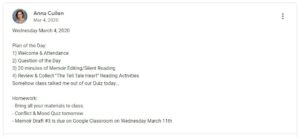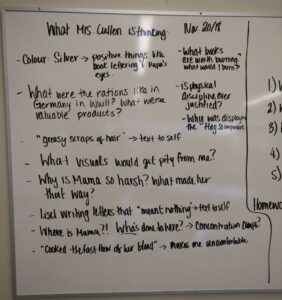Assignment 2A: Draft Unit Plan
For this assignment, I decided to write up a lesson plan for a novel study unit and incorporate FlipGrid as a new technology. I will be reflecting on an activity that I used in my English 10 class and is for an in-class instruction format.
ADDIE Model Reflection
Analysis
This lesson is for an English 10 class during a novel study unit. There are 30 students, including 2 students enrolled in the English Language Learner Program, 3 who have aged out of our program, but English is their second language, 5 students with Individual Education Plans, and 1 student with a Behaviour Intervention Plan.
The students are reading Chapter 3 of To Kill a Mockingbird by Harper Lee. I know that I want to find a technology that will be useful for providing formative feedback about student understanding as we read the novel and I would also like something that will offer an opportunity for students to practice oral language skills, as they tend to focus on writing skills in their summative assessments for this unit.
Based on my experience from teaching a novel study unit in previous semester, student analysis ranges in quality significantly depending on their past experiences and English teachers. Many students also tend to have a challenging time putting their raw initial thoughts into writing. And though they are given the opportunity to discuss thoughts orally in in-class literature circle discussions, many students are hesitant to share with peers at first, especially so early in the unit. As for reading, students vary greatly in their experience with reading, so reading the novel together as a class will be the best way forward to ensure that all students are following along. For stronger students, I would offer some bonus reading materials that will enhance their literary analysis.
In my in-person class, all students have access to internet and a Chromebook at school. Most also have access to a smartphone, a computer, and internet at home. At this point in the semester, students are familiar with using Google Classroom as a platform for posting daily plans, classroom handouts, and assignments.

Figure 1: Sample Screenshot from Google Classroom with Day Plan
Design
After analyzing the context of the lesson, I’ve concluded that using a gradual release of responsibility (Pearson & Gallagher, 1983) approach to reading analysis would be a good approach to developing student literary analysis skills this early in the unit. In the early stages of this approach, I would plan to use think-alouds (Ericsson & Simon, 1993; Wilhelm, 2001) to allow for student metacognitive thinking about what they are reading. During in-class time, I would model think-aloud techniques as we read a chapter together, then assign students to practice think-alouds at home with the next chapter of the book and record their process using FlipGrid.
As described in my analysis, we would be reading the novel together as a class. To keep up student engagement while reading (and so they don’t have to hear their teacher talk all the time), I will use an online audiobook program to read To Kill a Mockingbird. Two online resources I have found are Audible, which offers a quality version of our audiobook but for a small fee, and ESL-bits.net, which also offers the audiobook but requires consistent internet access to listen.
Development
In this section, I will incorporate the use of the ADDIE Blueprint to create a detailed plan for the lesson.
Activity description
Student in my English 10 course will read Chapter 3 and 4 of To Kill a Mockingbird and practice literary analysis using think-alouds modeled using a gradual release of responsibility. Chapter 3 will be read in class together and students will read Chapter 4 on their own. Formative assessment will be gathered in the format of exit slips at the end of in-class instruction and a FlipGrid clip submission for homework.
Anticipated learning outcomes
Students will draw on the following learning outcomes outlined in the BC Curriculum documents for Literary Studies 10: “Think critically, creatively, and reflectively to explore ideas within, between, and beyond texts” while reading the novel and “Demonstrate speaking and listening skills in a variety of formal and informal contexts for a range of purposes” when recording their think-alouds on FlipGrid.
Activity approach
Review background knowledge (previous chapter contents and reading strategies). Read novel together in class and model reading strategies using think-aloud. Students read following chapter independently and practice think-aloud using video technology. Review student analysis together as a class looking for effective strategies and interesting thoughts.
Technology to use
The following technology will need to be considered for this lesson:
- Visual Aid (PowerPoint & projector)
- Audiobook & audio speakers (Audible for in class; ESL-bits.net for students at home who want to listen)
- Formative Assessment (FlipGrid & Kahoot)
- Class Webpage (Google Classroom)
Activity details
Day 1. Create a formative “pop quiz” using content from Chapter 2 on Kahoot. Students sign up for quiz as bell work and start lesson with the activity. Review previous content from Chapter 2 and review thinking strategies as outlined in Powerful Readers: Thinking strategies to guide literacy instruction in secondary classrooms (Hadden & Gear, 2016). Have a visual aid to pair with review. Read through Chapter 3 together (approx. 25 minutes) as a class with students following along in their novels using Audible. Record point-form thoughts on the whiteboard as I read.

Figure 2: Sample Teacher Think-Aloud on the White Board
Pause every halfway and demonstrate a think-aloud of what we just read referencing specific reading strategies by walking students through my notes on the board. At the end of the chapter, students write down their own analysis (or using ideas from mine) on sticky notes and stick them into their novel. Any extra time at the end of the block is for students to start reading Chapter 4 on their own.
Homework. Students finish reading Chapter 4 of To Kill a Mockingbird. They can either read on their own or follow along while listening to the chapter on ESL-bits.net. Encourage students to jot down notes as they read on sticky notes. Once finished the chapter, students record and submit a 1 minute Think-Aloud with their initial interpretations of the chapter on FlipGrid. With notes of the day plan and homework, post link to the ESL-bits.net chapter and a link to the FlipGrid assignment.
Day 2. Put one sticky note on each student’s desk. For Bellwork, have students write the reading strategy they focused on in their Think-Aloud homework on a sticky note and stick it to the board in ‘like grouping.’ Review what patterns we see as a class. What strategies did everybody use? Review the content of Chapter 4 using visual aid. Play a few of the strong students’ video clips from FlipGrid up on the projector. Talk about their ideas and why it is a strong analysis. Start reading Chapter 5 together with students and teacher jotting down notes for a think-aloud as they listen. Read until the end of the block. They will record another FlipGrid think-aloud tonight and tomorrow they will share their thoughts in small groups using classroom Chromebooks.
Implement
Because I am currently on maternity leave and not teaching this course, I am not able to implement it at this time.
Evaluation
The evaluation activity in this lesson is formative and data will be gathered both from the Kahoot on Day 1 and the FlipGrid video for homework. This way I’ll have a better understanding of their reading comprehension so far and their ability to analyze the text. This practice evaluation uses the skills they will need to demonstrate later in the unit in their formal assessments (a literature circle discussion and a written analysis of a chapter) in a guided approach (gradual release of responsibility) that builds student confidence and skillset.
Looking back at the beginning of this process and reflecting on the planning, I believe this lesson effectively meets the needs of the purpose and people it is designed for. I will reevaluate when I am back in the classroom and able to try out this lesson.
References:
Audible. https://www.audible.ca/
Ericsson K. A., Simon H. A. (1993). Protocol Analysis: Verbal Reports as Data. Cambridge, MA: MIT Press.
FlipGrid. https://info.flipgrid.com/
Google Classroom. https://classroom.google.com/u/0/h
Hadden, K. & Gear. A. (2016) Powerful Readers: Thinking strategies to guide literacy instruction in secondary classrooms. Markham, Ontario: Pembroke Publishers.
Kahoot!. https://kahoot.com/
Literary Studies 10. BC’s Curriculum. https://curriculum.gov.bc.ca/curriculum/english-language-arts/10/literary-studies
Pearson, P. D. and M. C. Gallagher, “The Instruction of Reading Comprehension,” Contemporary Educational Psychology, 8,1983, pp. 317-344
To Kill a Mockingbird. ESL-bits. http://esl-bits.net/ESL.English.Learning.Audiobooks/Mockingbird/preview.html
Wilhelm, J. D. (2001). Improving Comprehension with Think-Aloud Strategies. New York: Scholastic Inc.
Image Credit: https://pixabay.com/photos/concept-man-papers-person-plan-1868728/






1 Comment
Add Yours →Hi Anna,
Please click to link below to view my peer feedback. If you have any trouble accessing it, please let me know!
https://docs.google.com/document/d/1inrUzlCR51fMIRef4OJl4XhlBdb-hmdOhSDy8a7-w1U/edit#
Ann